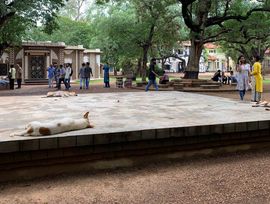A couple of weeks back, I was in Thiruvananthapuram to attend a few meetings. Afterwards, I visited an old artist friend, Shibu Natesan. He lives and works between three cities: Attingal, near Thiruvananthapuram—his home town; Baroda, where he studied, and London, where his wife and child lives. Shibu is a highly skilled painter, who switches effortlessly between different media like oil and watercolour.
The last time I visited his studio in Kerala was a decade ago. He leads a hermit’s life. He paints or sketches every day. Other daily practitioners include artists like A. Ramachandran and Laxma Goud. Whether it is outdoors or in studios, they enjoy daily practice. Shibu loves to travel to beaches and mountains in his jeep. His studio was full of small paintings, piled-up oil colour tubes, canvas tubes, watercolour palettes, brushes, easels, mirrors, hard-boards to paint on and objects from religious destinations.
It is always a joy to visit artists’ studios. During my student days at Sir J.J. School of Art, I used to visit studios of artists like Akbar Padamsee, Laxman Shreshta, Anju Dodiya and Atul Dodiya, Bhupen Khakhar, Prabhakar Barwe, Ramachandran, Sudarshan Shetty and many others. The learning was priceless and largely unavailable in college.
The other day, I was at the Santiniketan Society of Visual Art and Design (SSVAD) in West Bengal as part of an artists’ workshop and camp convened by Jogen Chowdhury. I have always had great memories of Santiniketan—its atmosphere, classrooms, K.G. Subramanyan’s murals, paintings, sculptures, studios and the greenery around the campus. SSVAD, a non-profit organisation, was set up by Janak Jhankar Narzary, Jogen Chowdhury and a few other like-minded people nine years ago. The funds were raised by selling artworks donated by eminent artists. The name is, of course, a play on the word svad meaning taste.
I think the idea originated from looking at the students at the Kala Bhavan in Santiniketan. After their formal education, where do they go and where do they practice and exhibit their works? SSVAD is trying to create opportunities for a new generation to boost their confidence and awareness of the art world through workshops, camps, residencies and symposia, and by providing exhibition and performance spaces. In recent years, SSVAD has acquired some more land and created a new studio for print-making and residences.
Shibu was also among the artists who were invited to give presentations at Kala Bhavan. On a very humid morning, the students sat on the tiled floors. I wondered how they were going to sit like that for three hours. But they did! Shibu made a presentation on his paintings in oil and watercolours, and spoke about his travels, his workspace and styles of paintings. Thereafter, it was my turn and I made a presentation on the art world, how to build a career in art, and the creation of the Kochi-Muziris Biennale, institutions and other art festivals.
Sanjayan Ghosh and Prashanta Sahu, both of whom teach at Kala Bhavan, had organised the conversation sessions with artists N.S. Harsha, T.V. Santhosh, Jagannath Panda, Shibu and myself. It went on for a long time and the students had a lot of questions.
I would like to mention here that this is my last ‘Everyone is a Camera’ column for THE WEEK for now. I wish to thank the good people at the publication. Perhaps, I can end with an anecdote from Kala Bhavan. After the conversation sessions, a young postgraduate student came up to me, showed me an issue of THE WEEK, and said: “Your column has given me so much information about the art world and it really has helped me to grow.” Here is to more healthy and creative conversations!
editor@theweek.in


